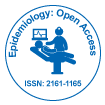开放获取期刊获得更多读者和引用
700 种期刊 和 15,000,000 名读者 每份期刊 获得 25,000 多名读者
索引于
- 哥白尼索引
- 谷歌学术
- 夏尔巴·罗密欧
- Genamics 期刊搜索
- 安全点亮
- 访问全球在线农业研究 (AGORA)
- 国际农业与生物科学中心 (CABI)
- 参考搜索
- 哈姆达大学
- 亚利桑那州EBSCO
- OCLC-世界猫
- CABI 全文
- 出租车直达
- 普布隆斯
- 日内瓦医学教育与研究基金会
- 欧洲酒吧
- ICMJE
有用的链接
开放获取期刊
分享此页面
抽象的
Correlation of Maternal Age and Migration on IHPS Epidemiology in Germany 2000-2008
Jan de Laffolie, Dirk Faas, Markus Hirschburger, Salmai Turial
A decline in the incidence of infantile hypertrophic pyloric stenosis (IHPS) was recently reported in Sweden, the US, Denmark, Scotland, and Germany. Data to explain this phenomenon, however, are scarce.
Given our previous epidemiologic data showing a decline in the incidence of IHPS, we collected data on maternal age and history of migration from regional administrative centers to obtain data that might support an explanation for our previous findings. We examined the correlation between these factors and the incidence of IHPS.
Data were extracted from the public report of health (Gesundheitsberichterstattung des Bundes) and population data from federal state governments. We obtained the numbers of IHPS (ICD-10 code 40.0) and live births in each federal state for the period 2000-2008.
Further data were collected from federal state administrative agencies on age of the mother at the birth of their first child and history of migration for all mothers at first birth.
There were significant differences in the regional distribution of both variables and the variability of these factors over time. Average maternal age and the percentage of mothers with a history of migration showed a negative correlation with the regional incidence of infantile hypertrophic pyloric stenosis.
Conclusion: The wide variation in the incidence of infantile hypertrophic pyloric stenosis over time and for different regions is significantly inversely correlated with rising maternal age and the percentage of mothers with a history of migration.

 English
English  Spanish
Spanish  Russian
Russian  German
German  French
French  Japanese
Japanese  Portuguese
Portuguese  Hindi
Hindi